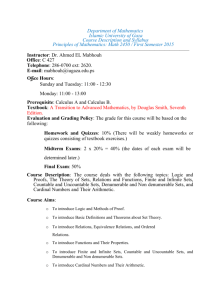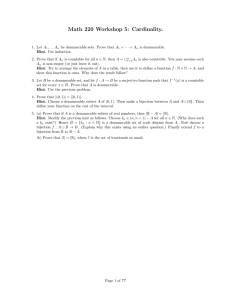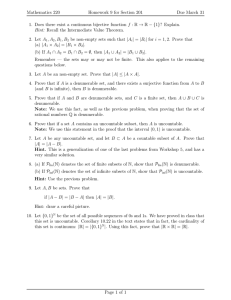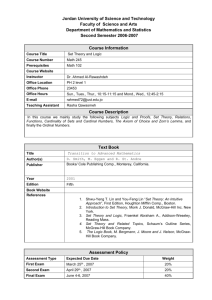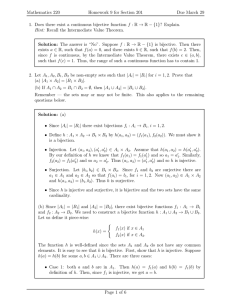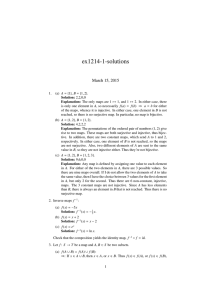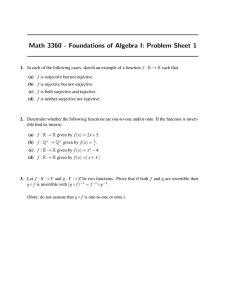Mathematics 220 Homework 10 Due April 7/8
advertisement
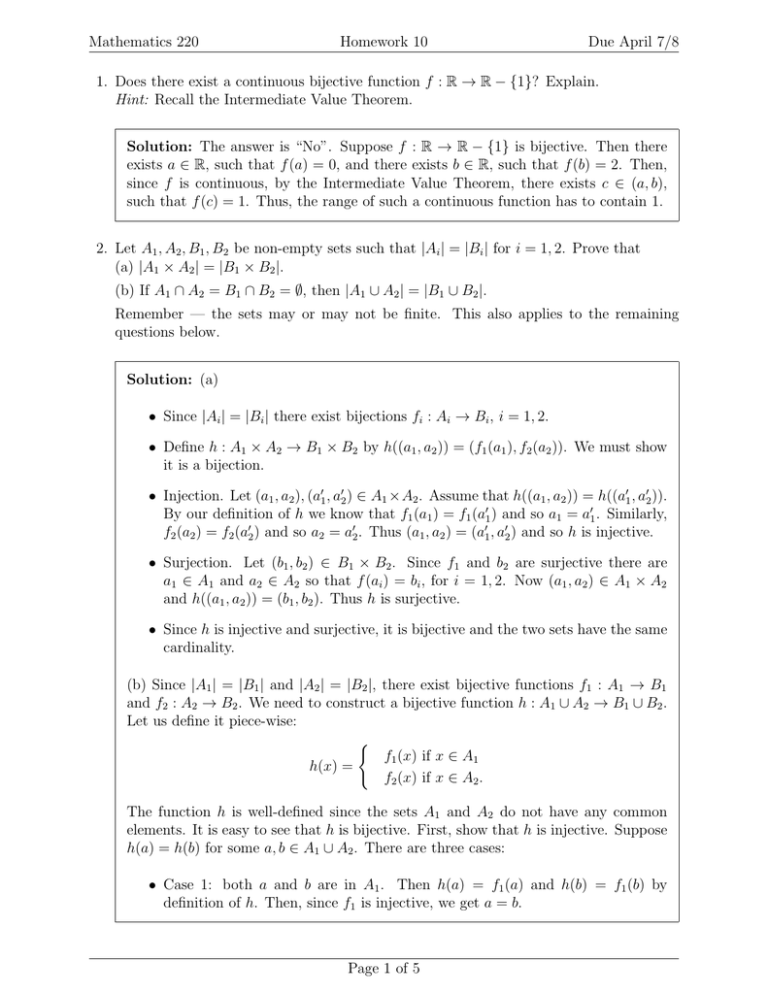
Mathematics 220
Homework 10
Due April 7/8
1. Does there exist a continuous bijective function f : R → R − {1}? Explain.
Hint: Recall the Intermediate Value Theorem.
Solution: The answer is “No”. Suppose f : R → R − {1} is bijective. Then there
exists a ∈ R, such that f (a) = 0, and there exists b ∈ R, such that f (b) = 2. Then,
since f is continuous, by the Intermediate Value Theorem, there exists c ∈ (a, b),
such that f (c) = 1. Thus, the range of such a continuous function has to contain 1.
2. Let A1 , A2 , B1 , B2 be non-empty sets such that |Ai | = |Bi | for i = 1, 2. Prove that
(a) |A1 × A2 | = |B1 × B2 |.
(b) If A1 ∩ A2 = B1 ∩ B2 = ∅, then |A1 ∪ A2 | = |B1 ∪ B2 |.
Remember — the sets may or may not be finite. This also applies to the remaining
questions below.
Solution: (a)
• Since |Ai | = |Bi | there exist bijections fi : Ai → Bi , i = 1, 2.
• Define h : A1 × A2 → B1 × B2 by h((a1 , a2 )) = (f1 (a1 ), f2 (a2 )). We must show
it is a bijection.
• Injection. Let (a1 , a2 ), (a01 , a02 ) ∈ A1 ×A2 . Assume that h((a1 , a2 )) = h((a01 , a02 )).
By our definition of h we know that f1 (a1 ) = f1 (a01 ) and so a1 = a01 . Similarly,
f2 (a2 ) = f2 (a02 ) and so a2 = a02 . Thus (a1 , a2 ) = (a01 , a02 ) and so h is injective.
• Surjection. Let (b1 , b2 ) ∈ B1 × B2 . Since f1 and b2 are surjective there are
a1 ∈ A1 and a2 ∈ A2 so that f (ai ) = bi , for i = 1, 2. Now (a1 , a2 ) ∈ A1 × A2
and h((a1 , a2 )) = (b1 , b2 ). Thus h is surjective.
• Since h is injective and surjective, it is bijective and the two sets have the same
cardinality.
(b) Since |A1 | = |B1 | and |A2 | = |B2 |, there exist bijective functions f1 : A1 → B1
and f2 : A2 → B2 . We need to construct a bijective function h : A1 ∪ A2 → B1 ∪ B2 .
Let us define it piece-wise:
(
f1 (x) if x ∈ A1
h(x) =
f2 (x) if x ∈ A2 .
The function h is well-defined since the sets A1 and A2 do not have any common
elements. It is easy to see that h is bijective. First, show that h is injective. Suppose
h(a) = h(b) for some a, b ∈ A1 ∪ A2 . There are three cases:
• Case 1: both a and b are in A1 . Then h(a) = f1 (a) and h(b) = f1 (b) by
definition of h. Then, since f1 is injective, we get a = b.
Page 1 of 5
Mathematics 220
Homework 10
Due April 7/8
• Case 2: both a and b are in A2 . This case is similar: since f2 is injective, we
get a = b.
• Case 3: one of the elements is in A1 , and the other – in A2 . We denote the one
that is in A1 by a. So, we have a ∈ A1 and b ∈ A2 . Then h(a) = f1 (a) ∈ B1 , and
h(b) = f2 (b) ∈ B2 , but since B1 ∩ B2 = ∅, in this case the equality h(a) = h(b)
is impossible.
Now let us prove that h is surjective. Let b ∈ B1 ∪ B2 . Then either b ∈ B1 or
b ∈ B2 . If b ∈ B1 , since f1 is surjective, there exists a ∈ A1 such that f1 (a) = b.
Since a ∈ A1 , by definition of h, we have h(a) = f1 (a) = b. So, we proved that there
exists a ∈ A1 ∪ A2 such that h(a) = b. The case b ∈ B2 is similar (replace A1 with
A2 everywhere).
3. Let A be an non-empty set. Prove that |A| ≤ |A × A|.
Solution:
• It suffices to find an injection from A to A × A.
• Define f : A → A × A by f (a) = (a, a).
• Let a, b ∈ A and assume f (a) = f (b). Thus (a, a) = (b, b) and so we must have
a = b. Hence f is injective.
4. Prove that if A is a denumerable set, and there exists a surjective function from A to B
, then B is countable.
Solution: It is given that there exists a surjective function g : A → B. The collection
of pre-image sets { g −1 ({b}); b ∈ B} makes a partition for A, so using axiom of choice
we can make a set by choosing one element from each part of this partition, call it
A1 . Then A1 is a subset of A such that g is a bijective function from A1 to B. So
|A1 | = |B| and since A1 ⊆ A we have |A1 | ≤ |A| = |N| so |B| ≤ |N|. Therefore B is
countble.
5. S
Given the indexed collection of denumerable sets Ai with i ∈ N, prove that their union
i∈N Ai is also denumerable.
Solution: We did this problem in class. Since every Ai is denumerable it will have
an infinite listing {ai,j ; j ∈ N}. Write these listings as the rows of an infinite matrix.
Now listing all the elements of this matrix in the off-diagonal direction (listing in
order of i + j increasing with i decreasing for those having equal values of i + j ) and
ignoring the repeated elements this gives us an infinite listing for the union.
Page 2 of 5
Mathematics 220
Homework 10
Due April 7/8
6. Prove that if a set A contains an uncountable subset, then A is uncountable.
Solution: Proof by contradiction: suppose A was countable. Then either A is finite
or it is denumerable. Clearly, a finite set cannot contain an uncountable subset (all
subsets of a finite set are finite). Then, A is denumerable. But we proved in class
that every subset of a denumerable set is either denumerable or finite. We get a
contradiction with the assumption that A contains an uncountable subset.
7. Let A be any uncountable set, and let B ⊂ A be a countable subset of A. Prove that
|A| = |A − B|.
Solution:
By the previous problem, A − B is infinite (if it was finite, A would have been a union
of a finite set and a countable set, and therefore, countable). Let C = {c1 , . . . cn , . . . }
be any denumerable subset of A − B (it seems obvious that we can just pick an
element c1 from the infinite set A − B, then pick any element c2 from the set of
remaining elements, and keep doing it; note, however, that technically, this is the
axiom of choice, which is mentioned in 10.5; it’s not on the exam though). Once we
have the set C, we know that C and C ∪ B are both denumerable, and therefore there
exists a bijective function f : C ∪ B → C. Now, define h : A → A − B by:
(
x,
x ∈ A − (C ∪ B)
h(x) =
f (x)
x ∈ C ∪ B.
Then by the problem 2b) (see its solution), h is a bijective function from A to A − B.
8. (a) If Pfin (N) denotes the set of finite subsets of N, show that Pfin (N) is denumerable.
(b) If Pinf (N) denotes the set of infinite subsets of N, show that Pinf (N) is uncountable.
Hint: Use the previous problem.
Solution: (a) Let An denote the set of subsets of N that are contained in {1, . . . , n}.
Then |An | = 2n (we proved this by induction). Now, note that any finite subset of N
is contained in {1, . . . , n} for a large enough number n. Therefore Pfin (N) = ∪∞
n=1 An
is a denumerable union of finite sets and is clearly an infinite set. Therefore it is
denumerable. (we have proved in class that denumerable union of denumerable sets
is denumerable, this implies that denumerable union of countable sets is countable.)
(b) Assume to the contrary that B1 = Pinf (N) is countable. By (a) B2 = Pfin (N) is
denumerable. If Bn = ∅ for all n ≥ 3 then P(N) = ∪∞
n=1 Bn is a denumerable union
of countable sets and therefore countable and since it is trivially infinite it will be
denumerable. This contradicts the fact (proven in class) that P(N) is uncountable.
Therefore the set of infinite subsets of N must be uncountable.
Page 3 of 5
Mathematics 220
Homework 10
Due April 7/8
9. Let A, B be sets. Prove that if |A − B| = |B − A| then |A| = |B|.
Hint: draw a careful picture.
Solution: Given a bijection f : (A − B) → (B − A) define
(
f (x) x ∈ (A − B)
g :A → B
g(x) =
x
x 6∈ (A − B)
• Let g : A → B be defined as above. We need to show that g is injective and
surjective.
• Injective. Let x, z ∈ A and assume g(x) = g(z). This image must be in B, but
it may either be in A or not in A (that is, either y ∈ A ∩ B or y ∈ B − A).
– Assume g(x) = g(z) 6∈ A. Then both x, z ∈ A − B (otherwise their images
under g would be in A). Hence g(x) = f (x) and g(z) = f (z). Since f is
injective, it follows that x = z.
– Now assume that g(x) = g(z) ∈ A. Then both x, z ∈ A (otherwise their
images under g would be in B − A). Then g(x) = x and g(z) = z and so
x = z.
Hence g is injective.
• Surjective. Let y ∈ B. Either y ∈ A or y 6∈ A (that is, either y ∈ A ∩ B or
y ∈ B − A).
– Assume y ∈ A then let x = y. By the definition of g, g(x) = x = y.
– Now assume y ∈
6 A, then since f is surjective, there exists x ∈ A − B so
that f (x) = y. Now since x ∈ A − B, it follows that g(x) = f (x) = y.
Hence g is surjective.
• Hence g(x) is bijective as required.
10. Let {0, 1}N be the set of all possible sequences of 0s and 1s. Corollary 10.22 in the text
states that, the cardinality of this set is continuum: |{0, 1}N | = |R|. Using this fact,
prove that |R × R| = |R|.
Solution: Define f : {0, 1}N × {0, 1}N → {0, 1}N by
(
x(m+1)/2 if m is odd
f ({xn }, {yn })m =
ym/2
if m is even.
We claim f is bijective. Let {zn } ∈ {0, 1}N . Define xn = z2n−1 and yn = z2n .
Then the above definitions easily imply that {zn } = f ({xn }, {yn }). Therefore f is
Page 4 of 5
Mathematics 220
Homework 10
Due April 7/8
onto. Assume f ({xn }, {yn } = f ({x0n }, {yn0 }). Equating the even coefficients of these
two sequences we find that {xn } = {x0n } and equating the odd coefficients we get
{yn } = {yn0 }. Therefore ({xn }, {yn }) = ({x0n }, {yn0 }), and so f is one-to-one.
It follows from the above that |{0, 1}N × {0, 1}N | = |{0, 1}N |. Now use Question 1(a)
and Corollary 10.20, the above equality and finally Corollary 10.20 again to conclude
that
|R × R| = |{0, 1}N × {0, 1}N | = |{0, 1}N | = |R|.
This completes the proof.
Page 5 of 5

